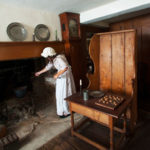Our Town
The historic New England town of Ridgefield combines an enviable rural setting for family living and outdoor enjoyment with an ideal location for travel by auto or rail to major business and commercial centers. Ridgefield is home to more than 8,800 households and 25,000 of the most affluent and best-educated people. Weekend visitors come from neighboring towns and as far away as New York City to stroll our historic Main Street, shop in our stores and dine in our many restaurants.
Ridgefield Attractions
Lounsbury House, Ridgefield’s Community Center, is the jewel of Ridgefield’s Main Street. It is the site of lavish weddings and major community and business events throughout the year. Just down Main Street from Lounsbury House is the Aldrich, a nationally recognized, world-class museum of contemporary art. With frequent reviews of Aldrich exhibits in the New York Times, art lovers from across the region keep the trip to Ridgefield at the top of their To Do list. Ridgefield boasts its own Playhouse, with a local movie theater as well as a remarkable year-round schedule of star-studded live performances.
Ridgefield Living
Residences in town present a wide selection of styles and sizes, including spacious single-family homes, renovated colonials, and elegant modern architecture. Charming condominium communities blend tastefully into the landscape. Waterfront properties dot the shores of the many lakes in town. The historic downtown village with stately mansions and unique shops adds to Ridgefield’s character. Numerous events occur throughout the village each year celebrating and supporting Arts, Entertainment, Fellowship and small town living.
Demographics
As of 2010 – 2014, there were 25,025 people, 8,801 households, and 6,611 families residing in the town. The population density was 686.7 people per square mile (265.1/km²). There were 9,320 housing units at an average density of 257.8 per square mile (99.5/km²). The racial makeup of the town was 96.12% White, 0.62% Black or African American, 0.09% Native American, 2.08% Asian, 0.03% Pacific Islander, 0.36% from other races, and 0.70% from two or more races. Hispanic or Latino of any race were 1.97% of the population.
There were 8,433 households out of which 43.0% had children under the age of 18 living with them, 70.6% were married couples living together, 6.0% had a female householder with no husband present, and 21.6% were non-families. 18.9% of all households were made up of individuals and 7.5% had someone living alone who was 65 years of age or older. The average household size was 2.78 and the average family size was 3.21.
In the town the population was spread out with 30.6% under the age of 18, 3.2% from 18 to 24, 27.8% from 25 to 44, 27.5% from 45 to 64, and 10.9% who were 65 years of age or older. The median age was 39 years. For every 100 females there were 92.8 males. For every 100 females age 18 and over, there were 89.4 males.
As of the census of 2000, there are 7,212 people, 2,933 households, and 1,994 families residing in the CDP. The population density is 1,125.2 people per square mile (434.4/km2). There are 3,078 housing units at an average density of 480.2 per square mile (185.4/km2). The racial makeup of the CDP is 95.52% White, 0.54% Black or African American, 0.11% Native American, 2.44% Asian, 0.01% Pacific Islander, 0.51% from other races, and 0.86% from two or more races, while 2.26% of the population are Hispanic or Latino of any race.
There are 2,933 households out of which 34.4% have children under the age of 18 living with them, 57.7% are married couples living together, 8.1% have a female householder with no husband present, and 32.0% are non-families. Of all households 28.5% are made up of individuals and 12.3% have someone living alone who is 65 years of age or older. The average household size is 2.46 and the average family size is 3.05.
In the CDP the population is spread out with 26.9% under the age of 18, 3.3% from 18 to 24, 28.5% from 25 to 44, 27.9% from 45 to 64, and 13.4% who are 65 years of age or older. The median age is 41 years. For every 100 females there are 89.4 males. For every 100 females age 18 and over, there are 85.5 males.
History
Ridgefield was first settled by English colonists from Norwalk and Milford in 1708, when a group of settlers purchased land from Chief Catoonah (also known as Chief Katonah) of the Ramapo tribe. The town was incorporated under a royal charter from the Connecticut General Assembly issued in 1709. 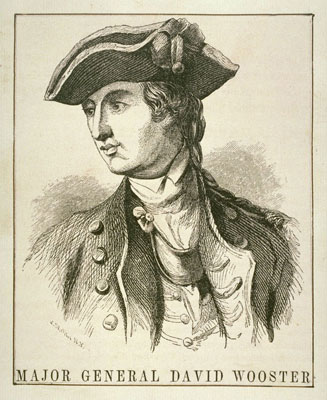 The most notable 18th-century event was the Battle of Ridgefield on April 27, 1777. This American Revolutionary War skirmish involved a small colonial militia force (state militia and some Continental Army soldiers), led by, among others, General David Wooster, who died in the engagement, and Benedict Arnold, whose horse was shot from under him. They faced a larger British force that had landed at Westport and was returning from a raid on the colonial supply depot in Danbury. The battle was a tactical victory for the British but a strategic one for the Colonials because the British would never again conduct inland operations in Connecticut, despite western Connecticut’s strategic importance in securing the Hudson River Valley. Today, the dead from both sides are buried together in a small cemetery on Main Street on the right of the entrance to Casagmo condominiums: “…foes in arms, brothers in death…”. In the summer of 1781, the French army under the Comte de Rochambeau marched through Connecticut, encamping in the Ridgebury section of town. There are many landmarks from the Revolutionary War in the town, with most along Main Street.
The most notable 18th-century event was the Battle of Ridgefield on April 27, 1777. This American Revolutionary War skirmish involved a small colonial militia force (state militia and some Continental Army soldiers), led by, among others, General David Wooster, who died in the engagement, and Benedict Arnold, whose horse was shot from under him. They faced a larger British force that had landed at Westport and was returning from a raid on the colonial supply depot in Danbury. The battle was a tactical victory for the British but a strategic one for the Colonials because the British would never again conduct inland operations in Connecticut, despite western Connecticut’s strategic importance in securing the Hudson River Valley. Today, the dead from both sides are buried together in a small cemetery on Main Street on the right of the entrance to Casagmo condominiums: “…foes in arms, brothers in death…”. In the summer of 1781, the French army under the Comte de Rochambeau marched through Connecticut, encamping in the Ridgebury section of town. There are many landmarks from the Revolutionary War in the town, with most along Main Street.
During the weekend of April 29th 2017, the 1777 Wooster-Sons of Liberty Foundation, and Jerusalem 49 Masonic Lodge of 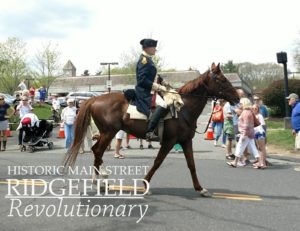 Ridgefield sponsored and hosted a reenactment of the 1777 Battle of Ridgefield. The reenactment included personalities in full period costumes. British troops bivouacked in an encampment at Ballard park; the 5th Connecticut Regiment of the Continental Army and colonialist militias established their encampment at Keeler Tavern Museum.
Ridgefield sponsored and hosted a reenactment of the 1777 Battle of Ridgefield. The reenactment included personalities in full period costumes. British troops bivouacked in an encampment at Ballard park; the 5th Connecticut Regiment of the Continental Army and colonialist militias established their encampment at Keeler Tavern Museum.
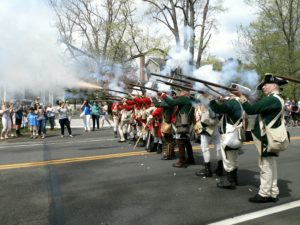 This is the closet you could come to being there 240 years ago—as ordinary Americans, local militias and Washington’s Continental Army, confronted and engaged the superior British force that had just destroyed Danbury and the Continental Army’s supplies for the war effort.
This is the closet you could come to being there 240 years ago—as ordinary Americans, local militias and Washington’s Continental Army, confronted and engaged the superior British force that had just destroyed Danbury and the Continental Army’s supplies for the war effort.
A rememberance of the Americans fighting for and believing in freedom and liberty not yet 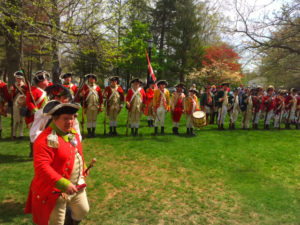 secured in the newly birthed United States of America.
secured in the newly birthed United States of America.
Guests observed the march of the British from Danbury through Ridgefield, the live smelting and pouring of musket balls, canon fire, live skirmishes and reenactment practice drills with the soldiers.
There was an eye opening look into the past, including the chores, responsibilities and lifestyles of American and British Soldiers, the conditions and challenging hardships endured and conquered by Americans as a high but critical price for liberty.
Our appreciation to Addessi Jewelers for the reenactment photos above.
For much of its three centuries, Ridgefield was a farming community. Among the important families in the 19th century were 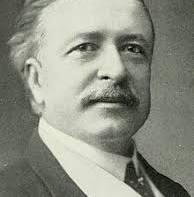 the Rockwells and Lounsburys, which intermarried. They produced two Connecticut governors, George Lounsbury and Phineas Lounsbury. The Ridgefield Veterans Memorial Community Center on Main Street, also called the Lounsbury House, was built by Gov. Phineas Chapman Lounsbury around 1896 as his primary residence. The Lounsbury Farm near the Florida section of Ridgefield is one of the only remaining operational farms in Ridgefield.
the Rockwells and Lounsburys, which intermarried. They produced two Connecticut governors, George Lounsbury and Phineas Lounsbury. The Ridgefield Veterans Memorial Community Center on Main Street, also called the Lounsbury House, was built by Gov. Phineas Chapman Lounsbury around 1896 as his primary residence. The Lounsbury Farm near the Florida section of Ridgefield is one of the only remaining operational farms in Ridgefield.
Government
Ridgefield has a traditional New England Board of Selectmen–Town Meeting form of government, which is created by Town Charter and approved by the voters. The chief executive is The First Selectman, who also serves a legislative function as a member of the Board of Selectmen. The current First Selectman, Rudy Marconi (D), was first elected in 1999.
Geography
According to the United States Census Bureau, the town has a total area of 35.0 square miles (91 km2), of which 34.4 square miles (89 km2) is land and 0.5 square miles (1.3 km2), or 1.52%, is water. The town is bordered by the towns of North Salem and Lewisboro in Westchester County, New York to the west, Danbury to the north, Wilton to the south and Redding to the east.
The town has a Metro-North Railroad station called Branchville in the Branchville corner of town.
Attractions, Landmarks, and Institutions
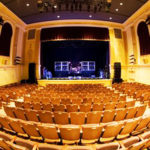 The Ridgefield Playhouse is a venue known for music events and performing arts, located in Ridgefield, CT. Opened in 1938. The venue features seating for 500 people and has hosted events for Paul Anka, Bruce Hornsby, Metropolitan Opera, Ron White, and Jewel, among other concert, comedy, and theatre events.
The Ridgefield Playhouse is a venue known for music events and performing arts, located in Ridgefield, CT. Opened in 1938. The venue features seating for 500 people and has hosted events for Paul Anka, Bruce Hornsby, Metropolitan Opera, Ron White, and Jewel, among other concert, comedy, and theatre events.
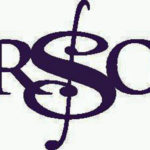 The Ridgefield Symphony Orchestra began as the “Ridgefield Symphonette” in 1965 with 20 players, only a third of them professionals. It became fully professional by the end of the decade and today has 75 musicians and draws soloists of international reputation.
The Ridgefield Symphony Orchestra began as the “Ridgefield Symphonette” in 1965 with 20 players, only a third of them professionals. It became fully professional by the end of the decade and today has 75 musicians and draws soloists of international reputation.
The Keeler Tavern Museum preserves an early 18th-century house that, by the time of the Revolution, had become a tavern and inn. The tavern was a center of community activities, an early post office, and a stop on the northern New York to Boston post road. In the early 20th century, it was the home of noted architect Cass Gilbert. The tavern is open several days a week, offers tours, and has a gift shop. The Keeler Tavern features a British cannonball still lodged in the side of the building.
The Aldrich Contemporary Art Museum is a leading venue for the world’s best contemporary artists. 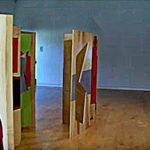 Its exhibitions have attracted national attention and respect. The museum was redesigned and expanded in 2004, and offers many special programs, including concerts.
Its exhibitions have attracted national attention and respect. The museum was redesigned and expanded in 2004, and offers many special programs, including concerts.
The Ridgefield Playhouse opened December 2000, is housed in the former Ridgefield Alternate High School auditorium, and was remodeled as a playhouse. It is the year-round venue for dozens of concerts and other performances, many by internationally known artists. The Playhouse also shows movies, many of them first-run.
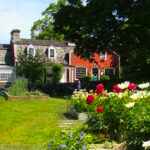 Weir Farm National Historic Site, which straddles the Ridgefield-Wilton border, preserves much of the farm of J. Alden Weir (1852–1919), a painter of the American Impressionism style. The property was later used by his son-in-law, Mahonri Young (1877–1957), noted sculptor and a grandson of Brigham Young. The site includes the Weir Farm Art Center and a gallery, and many special events take place there, including shows by visiting artists in residence. Weir Farm is one of only two official National Park Service units in the state.
Weir Farm National Historic Site, which straddles the Ridgefield-Wilton border, preserves much of the farm of J. Alden Weir (1852–1919), a painter of the American Impressionism style. The property was later used by his son-in-law, Mahonri Young (1877–1957), noted sculptor and a grandson of Brigham Young. The site includes the Weir Farm Art Center and a gallery, and many special events take place there, including shows by visiting artists in residence. Weir Farm is one of only two official National Park Service units in the state.
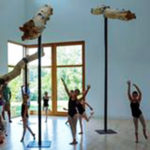 The Ridgefield Conservatory of Dance was founded as the Ridgefield Studio of Classical Ballet in 1965 by Patricia Schuster. In 2002 it became the Ridgefield Conservatory of Dance, a non-profit 501(c) 3 organization.
The Ridgefield Conservatory of Dance was founded as the Ridgefield Studio of Classical Ballet in 1965 by Patricia Schuster. In 2002 it became the Ridgefield Conservatory of Dance, a non-profit 501(c) 3 organization.
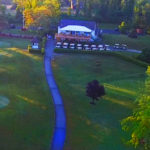 Ridgefield Golf Course is the town’s municipal 18 hole golf course designed by George Fazio and Tom Fazio and opened in 1974.
Ridgefield Golf Course is the town’s municipal 18 hole golf course designed by George Fazio and Tom Fazio and opened in 1974.
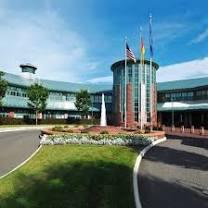 The town’s largest industry is Boehringer Ingelheim Pharmaceuticals, whose United States headquarters are located in the Ridgebury section of town.
The town’s largest industry is Boehringer Ingelheim Pharmaceuticals, whose United States headquarters are located in the Ridgebury section of town.

